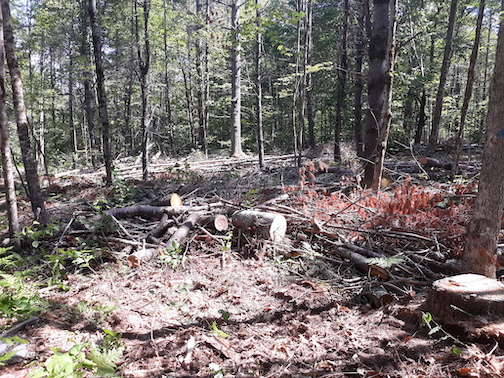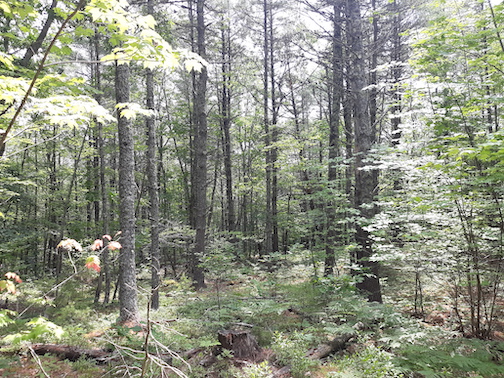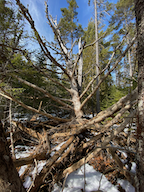By Noah Gleason-Hart
When folks envision a healthy forest, they often imagine neat, open, parklike stands with little understory and no dead or declining trees. In truth, at least in the woods, messy is good. A vibrant, functioning forest is a maze of complexity and “messiness.” Dead, diseased and dying trees coexist alongside vigorous, fast-growing trees in the canopy. Gaps, where trees have fallen out of the canopy due to wind events, old age or disease, are a tangle of dense seedlings and the forest floor is covered in downed trees and branches in the process of decaying. These dead and down trees, called coarse woody material, are extremely important. They store carbon for long periods, provide animal habitat and food sources, retain moisture, protect regenerating trees and play a crucial role in cycling nutrients back into the soil.
Unfortunately, because most of our forests in New England are young, and we’ve spent decades harvesting wood in ways that simplify our naturally complex ecosystems, many of our forests lack crucial dead, dying and down woody material. To restore these conditions, we must accept that our socially constructed ideas about order and cleanliness are not a good fit for forests. We need to reimagine our views on forest aesthetics and see the beauty in, or at least the value of, disorder in the woods. Once we accept this idea, how do we apply it to the forests we steward?
Thankfully, we can use logging — the same tool that simplified our forests — to restore natural conditions in human-disturbed forests more quickly than they could occur on their own. To do this, we first have to challenge some of our assumptions about what it means to log carefully and reexamine some of the measures we use to judge harvest success.


Don’t Cut Up Logging Slash
For example, harvest contracts often stipulate that if trees are hand-felled and then limbed in the woods, branches and tops — called slash — must be cut up enough, so slash is never piled above knee height. This makes sense if our goal is to create an ordered, parklike forest. Large uncut tops and limbs on even a moderately intense harvest pile up quickly and can be visually jarring, so cutting them small makes them look neater and disappear more rapidly.
However, cutting slash small has no positive impacts on forest health, limits its utility as wildlife habitat, and does not protect regeneration from animal browsing as well as tall slash does. Importantly, because diced slash decomposes more quickly, it releases its stored carbon faster and provides ecological benefits for a shorter period.
Also, the work of limbing and cutting tops is time-consuming, dangerous work that loggers are not directly compensated for in the production-based payment system that is most common in our region. If we remove small slash stipulations from contracts, a logger can refocus that time and attention on executing other parts of the harvest, like avoiding residual stand damage, that actually have long-term positive effects.
Leave Low-Value Wood on the Ground to Rot
We often assume that all the saleable parts of trees cut during a harvest should be taken to the landing and sold. Harvest contracts often stipulate this and require that all tree sections with a specific top diameter — often 4 inches or larger — must be removed and utilized. These contract standards are often driven by the long-held belief that leaving wood to rot is a wasteful eyesore and an irresponsible use of the resource. However, if we recognize that having rotting wood in the forest is vital to ecosystem function and not a waste, then the only reason to remove this material from woods is to make a harvest financially viable.
There are pulp and some other markets available for small-diameter wood and low-quality trees, but demand can be sporadic, and prices low. Sometimes, the financial return from selling pulp makes a thoughtful harvest possible but not always. You and your forester should take a clear-eyed look at whether selling this wood from your land makes sense, given site conditions, market access, and the productivity potential of the equipment types you will use. If shipping low-quality and small wood doesn’t help you reach your goals, it’s far better to leave it lying in the woods to decompose.
Make the Right Kind of Mess
It’s important to clarify that advocating for a recalibration of some ways that we measure harvest success is not a justification of careless logging practices or high grading that damages the productivity and integrity of your forest. Even if our goal is messiness, we must continue to cut low-quality trees in our forest to release sound trees and avoid accidentally using the “cut the best, leave the rest” highgrading approach that has served our forest poorly for centuries. Instead, the change in approach is that we should be thoughtful about which trees we remove from the forest after felling, and which ones have more value remaining as deadwood on the forest floor.
The quality of the forest left behind is the primary product of any timber harvest, and excessive damage to residual trees by logging equipment degrades your forest and has real ecological and financial consequences. Finally, rutting caused by using inappropriate equipment on wet sites at the wrong time of year can permanently damage soil structure and productivity that can’t be fixed by regrading trails at the end of the harvest. Those are not the kinds of messes that we want to leave in our woods.

Create Standing Dead Trees
The final component you can add to your now messy forest is more standing dead trees.
In areas with low foot traffic, this is best done by girdling — making a shallow chainsaw cut through the bark all the way around the stem. This cuts off nutrient flow to the tree and slowly kills it, ensuring it will remain a standing dead snag for a long time. Girdling is a great technique to use on trees with low financial value, like multi-stemmed, field-grown white pines that are competing with trees you’d like to grow but are challenging to fell safely or without damaging other trees.
Find a Balance Between Order and Ecology for You and Your Forest
We often have to balance potentially competing objectives as thoughtful forest stewards. It’s true that dead-standing trees can pose a real safety risk in high-traffic areas of your forest and large amounts of dead woody material may also limit some recreational activities and accessibility for those with mobility challenges. In those cases, a compromise might be to keep slash off your recreational trails, reduce the amount of slash left in the few acres around your home and only create dead-standing trees in remote corners of your property.
Finally, remember that forests change rapidly. After a few years, new green growth will hide slash piles as they break down. You might find that your perspective changes too, and with time you may begin to see the messy forest you once considered an eyesore as a healthy, vibrant ecosystem.
Noah Gleason-Hart is MOFGA’s low-impact forestry specialist. You can contact him at [email protected].
This article originally appeared in the spring 2023 issue of The Maine Organic Farmer & Gardener.
